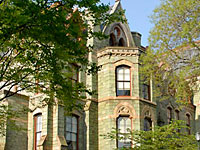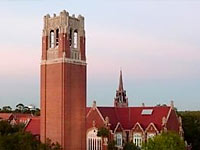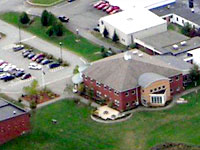Four years at a private college now totals a record $109,000 on average – not including room and board. That's a reality that thousands of parents of soon-to-be college students are starting to face, now that the 2011 Free Application for Federal Student Aid is available. But at a surprising number of schools around the country, tuition is actually free. And at many of them, there's still time to apply.
Yes, completely free tuition is still the exception, but colleges all over the country are getting more generous. Last year, the number of colleges with a "no-loans" policy, which guarantees aid in grants instead of loans, grew by 21%; now 74 colleges, including all of the Ivy League, have such a policy. And as more families grapple with the cost of college, a college's generosity – more than its math department, football team, or social scene – may be the tipping point for interested students.
Colleges and universities know this, of course, which is why they've gotten more generous: A good financial aid package is a competitive advantage. "We want to make sure we're not walking over the next poet laureate," says Douglas Christiansen, vice provost for enrollment and dean of admissions at Vanderbilt University, which has a no-loans policy. And the more generous a school can be, the more economically diverse its student population can be. The result, says Bill Schilling, director of financial aid at the University of Pennsylvania, which has a no-loans program, is "the kind of broad diversity where students are interacting day-to-day with other students from very different backgrounds."
For students and their families, the benefits may be more tangible: The chance to graduate from college without a crippling debt burden. SmartMoney found three types of four-year colleges and universities—and one group of two-year colleges—that could save families tens of thousands of dollars in tuition and fees. Many are highly regarded, including a number of Ivy League institutions and sought-after specialized schools. And some of these schools are still accepting applications for incoming freshmen and transfer students. Junior, make one more copy of that Common Application.
Free Tuition
 Cooper Union Cooper Union |
In the heart of New York City's East Village sits the campus of Cooper Union, an undergraduate school renowned for its engineering, architecture and art programs. Oh, yes, and its free tuition. Founded in 1859 by Peter Cooper, an industrialist and one-time presidential candidate (he represented the Greenback Party and lost to Rutherford Hayes in 1876), the school has been free since it opened, in keeping with Cooper's desire to offer higher education for working class students. Today, the school relies on an endowment of approximately $600 million to keep tuition free, a feature which remains a strong draw for the 4,200 students who apply each year. In addition to the typical college application, the architecture and art programs require completing a home test of artistic talent. It's too late to meet those deadlines, but the engineering school, which requires SAT II scores in math and science, is accepting applications until Jan. 31. The acceptance rate? A measly 8%, lower than Princeton, Columbia and MIT.
Cooper Union is one of a handful of schools where tuition is free for its entire undergraduate body (see list below). Another handful of schools have pledged to give free tuition to students whose families fall below certain income thresholds. At Dartmouth College, students' families must earn less than $75,000 to qualify; at Harvard College, it's less than $60,000.
But free tuition doesn't mean an entirely free experience. Cooper Union, like other tuition-free specialty schools, doesn't cover room and board, which costs roughly $14,000 per year at the New York school or fees that can run $1,600 per year. And some ask for something in return: At Alice Lloyd College, in Pippa Passes, Ky., where room and board costs up to $4,300, students must do community work or an on-campus job, says Jim Stepp, executive vice president at the school. (Application deadline is June 1 and the school is free for Central Appalachia residents.) The five U.S. service academies are free, but graduates commit to serving five years in the military post-graduation—and in some cases to pitch in a one-time $2,000 fee to cover uniforms and other items. (Deadlines to apply range from Jan. 31 to March 1.)
Other Options
Curtis Institute of Music, City University of New York Macaulay Honors College, Deep Springs College (all-male).
No-Loans Schools
 University of Pennsylvania University of Pennsylvania |
Once a bastion of the wealthy elite, Ivy League schools have been looking for ways to attract more students regardless of ability to pay since 1998, when Princeton replaced loans with grants for eligible students. University of Pennsylvania was a relative latecomer, adopting its own no-loans policy in 2006, but it's gotten increasingly generous: This year, the university increased its financial aid budget by 14% over last academic year, says Schilling, and all students who qualify for financial aid are now awarded grants instead of loans, regardless of family income. The aid is supported by tuition revenue (costs have been rising at a rate of 4% per year), as well as by the undergraduate college's endowment and donations.
The University of Pennsylvania is one of 15 schools that have made its policy to all eligible students. At other schools, eligibility varies: Some state schools replace loans with grants, but only for in-state students. Others restrict eligibility only to students at certain income levels. Brown University, for example, eliminates loans for families with incomes under $100,000; Vassar College will do the same for students from families making less than $60,000. (For a comprehensive list, see FinAid.org.)
Eliminating loans can be a huge advantage to undergraduates, who graduate with more than $23,000 in student debt on average. But there's often still a bill to pay, what's called the "expected family contribution." Using the FAFSA, the government determines how much a student's family is expected to pay. At a private college, the average yearly parental contribution is $21,216, according to Sallie Mae -- and many families cover at least part of that amount with private loans. You can estimate your family contribution with this FinAid.org calculator.
Other Options
Boston University (for income-eligible students who graduate from Boston's public schools); Rice University (for families with income of $80,000 or less); Vanderbilt University (for all students receiving need-based aid). At many no-loans schools, application deadlines for freshmen have passed, but transfer students have until early to mid March.
Bargains for In-State Residents
 Courtesy of Ray Carson Courtesy of Ray Carson |
In addition to football fans, the University of Florida, Gainesville, attracts hundreds of aspiring scientists: this academic year, university researchers have worked on liver transplants, food-borne illnesses, and tracked migrations of blue sharks. One of the top public colleges, it's also one of the cheapest – tuition and fees total $5,040 per year. And about 70% of undergrads get more help from the state's Bright Futures Scholarship program, which the legislature started in 1997 to provide tuition help to students with stellar grades and SAT scores – and to keep more students in state for college and beyond. (It's funded by state lottery revenues.) The scholarship currently pays up to around 75% of the school's tuition, which means eligible students pay less than $1,300 in tuition a year. However, the program cut back on funding in 2008 after lottery intakes declined.
While a good state school like University of Florida remains the cheapest option for many students, tuition and fees at most public colleges have been been rising as states cut back their support. The University of Florida increased tuition and fees by 15% since last year; the University of Califoria school system, home to top-ranked University of California at Berkeley, raised tuition by 32% during the last two years, sparking widespread student protests across the state. Double-digit increases are expected at more public colleges next year, says Mark Kantrowitz, publisher of FinAid.org, which tracks financial aid issues, but students aren't receiving much more in aid: State aid has risen by just 1% in total over the last 15 years in constant dollars, according to the State Higher Education Executive Officers.
Other Options
University of North Carolina at Chapel Hill (around $6,700 per year in tuition and fees); University of Texas at Austin ($10,400); University of Washington ($12,600). Deadlines for 2011 fall admission have passed at most state schools; transfer students still have time, and freshmen interested in winter or spring admission are accepted through the fall.
The Two-Year Option
 Washington County Community College Washington County Community College |
The more expensive four-year colleges get, the better community colleges start to look. In 2009, 3.4 million people enrolled in community colleges as full-time students, up 16.4% over the year before, according to the most recent data from the American Association of Community Colleges. No longer perceived as a consolation prize for students with lower grades, many community colleges now offer strong academics and courses that easily transfer to large public and private universities. Several states, including California and Florida, now have "common course numbering," which means English 101 at a community college is equivalent to the same course at a four-year public or private institution, says an AACC spokeswoman. And they're cheap. Some of the best, according to some ratings, charge less than $4,000 per year and many have instituted tuition freezes. In Maine, a tuition freeze means annual tuition at the well-regarded Washington County Community College is only $3,514--and enrollment at the school, which offers 15 associate's degree programs--has increased of 10% in the past year, says Darin McGaw, dean of enrollment services. For those in need, they also offer financial aid and scholarships.
